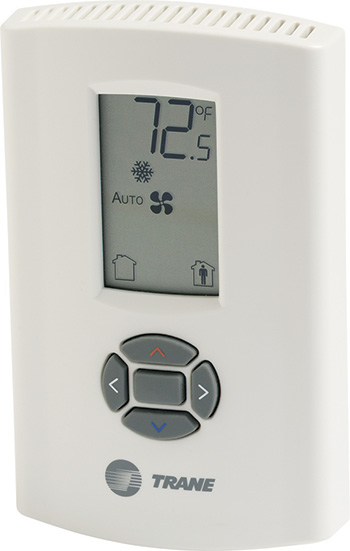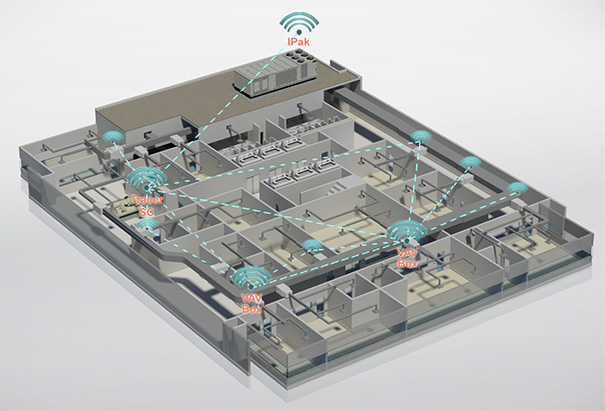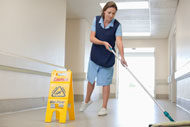 |
| Wireless zone sensors measure the local space temperature and allow occupants to change the room temperature. Photo courtesy of Trane, a brand of Ingersoll Rand |
Health care facilities have been major participants in the wireless revolution that has taken place over the past decade. Today, health facilities professionals and hospital administrative staff rely primarily on wireless technology to connect with each other and access a wide range of applications and data on hospital computer networks.
In fact, according to a 2013 survey by AmericanEHR Partners, a partnership between Cientis Technologies and the American College of Physicians, wireless devices have become standard in the hospital setting, especially in health care facilities and medical practices that have adopted electronic health record (EHR) systems.
Wireless communications technology also has moved into the facilities management realm, where it enables the reliable performance of building automation system (BAS) technology and mission-essential building systems. These include heating, ventilation and air conditioning (HVAC) systems and components that are equipped with direct digital control (DDC) technology that enables centralized control and the interoperability of HVAC and other building system components.
Wireless automation
Today’s most advanced wireless systems run the building automation and control network (BACnet) protocol over the ZigBee Building Automation standards. BACnet allows the BAS to communicate directly with disparate systems including HVAC, lighting, access control, fire detection and others. ZigBee offers a global standard for interoperable products enabling the secure and dependable monitoring and control of commercial building systems. It is the only BACnet-approved wireless mesh network standard for commercial buildings.
Wireless BAS technologies also adhere to Institute of Electrical and Electronics Engineers (IEEE) standards, which ensure that the wireless communication system will coexist with other wireless systems used in the facility, including Bluetooth and Wi-Fi. By using these industrywide standards, the most advanced BAS technologies enable secure and reliable wireless monitoring and control over hospital building systems that exist today and those that will be developed in the future.
Reliability is particularly important in a health care setting. Redundant, self-repairing mesh technology keeps wireless communications links open, thanks to a feature that automatically routes signals around any obstructions. This provides a distinct advantage over hard-wired applications, which can fail either permanently or intermittently when wires are cut, damaged or disconnected.
Recent advancements have further improved the effectiveness and reliability of the most advanced wireless BAS solutions. These advancements include further reductions in power consumption and longer-life batteries for remote sensors. Also, high-performance routers can double the range of previous-generation equipment, simplifying installation and reducing installation and operating costs. In addition, the use of more advanced routers eliminates the need to install repeaters to spread the signal throughout the hospital building.
Multiple advantages
Wireless BAS solutions are more flexible, can be installed in considerably less time and can cost much less to install and maintain than conventional hard-wired applications. In addition, wireless BAS solutions offer enhanced reliability and performance compared to the alternative.
There are three major advantages to implementing a wireless building automation solution in the health care environment:
• Efficient BAS projects. Wireless infrastructure significantly simplifies building control projects in both new and existing hospital buildings, making life easier for designers, engineers, contractors and building operators.
On the front end, the time and expense required to engineer, estimate and manage communications tasks is significantly reduced. Delays are minimized and labor costs are reduced because there are no wires to be pulled, tested and repaired.
In addition, zone sensors, controllers and other hardware can be installed quickly and efficiently, without penetrating structures. The fact that hardware can be attached directly to the wall or ceiling without penetrating the structure reduces the incidence of dust and other airborne contaminants that can negatively impact hospital indoor air quality (IAQ) and infection control protocols and saves cleanup time and costs. Sensors can be placed almost anywhere they are needed and can be easily relocated to improve data collection and occupant comfort.
The cost of placing and relocating sensors is much less in a wireless solution. In fact, it takes about 90 minutes per zone to relocate wired sensors. This compares to less than 15 minutes for wireless sensors.
Savings in time is particularly important in the health care environment in which contractors often have a small window of time to complete their work without disrupting hospital operations, shutting down revenue-generating activities or equipment or inconveniencing patients or hospital staff.
 |
|
Self-healing wireless mesh technology provides a reliable communications network between wireless sensors, HVAC systems and building controls. Graphic courtesy of Trane, a brand of Ingersoll Rand |
• Easier problem solving. Problem solving is easier in a wireless solution because there are no cut wires, bad connections or compromised wires to take the communications network down. This results in significant time savings because the challenge of troubleshooting and repairing faulty wiring hidden behind walls is eliminated. Unlike hard-wired solutions, wireless applications operate with wireless mesh that provides multiple data paths to keep the system up and running reliably.
In addition, it is easy and less expensive to relocate devices to improve sensing and control, even after a project is completed. During the building design phase, it is nearly impossible to know exactly where sensors should be placed in a given hospital department, room or office area because the designer does not always know where equipment will be placed within a given room.
For example, the effectiveness of an HVAC sensor or thermostat may be compromised if it is positioned near a patient monitor, copy machine or other heat-generating piece of equipment. This can cause the room to be overcooled, which affects occupant comfort and wastes energy.
There may be an operational or aesthetic reason why the equipment cannot be moved. But moving the sensors is easy and inexpensive because their position is not constrained by wire. The true flexibility and cost-effectiveness of a wireless solution is revealed when hospital rooms, departments or full floors are reconfigured or remodeled, because sensors and controllers can be easily moved at a minimal cost.
• Lifecycle savings. Wireless solutions significantly reduce the cost of building control projects in both new and existing structures. Design and engineering costs take less time and fast, trouble-free installation contributes to on-time, on-budget project completion. Major steps in the rewiring process can be eliminated altogether; for example, there is seldom a need to conduct a pre-installation site survey in most buildings.
Material and labor costs are reduced because the process of establishing a BAS communications link is dramatically simplified. Designers are not bound by the wire when it comes to placing zone sensors and other system components. Sensors and user interface devices can be placed where they make the most sense from a systems efficiency perspective — on columns, cubical walls or wherever else they can detect true conditions within the hospital.
BAS devices often need to be moved over the course of building’s full life cycle, a process that is much easier with a wireless solution. Because it is much quicker to reconfigure a wireless BAS communications network than a hard-wired network, changes are easier, quicker and cheaper to make. But just as importantly, they are less likely to disrupt hospital operations or leave expensive equipment sitting idle.
Finally, wireless BAS networks contribute to lifecycle energy efficiency and operating cost savings because they are less expensive to maintain and enable operators to place sensors and other devices where they will have the greatest impact on organizational efficiency and effectiveness.
The ideal time
Rapid growth in the use of wireless technology in the health care environment, combined with significant improvements in wireless performance and reliability have made this the ideal time for health care organizations to consider the advantages of a wireless solution for both new construction and retrofits. Wireless can help overcome retrofit difficulties and reduce costs in existing buildings, make upgrades to the BAS feasible.
Enabled by wireless solutions, hospital administrators and their facility management teams can do a better job of improving comfort, reducing energy use and operating costs, shrinking their environmental footprint and creating a positive environment of care for patients, staff and visitors.
Jim Kohl is senior product manager for Trane, a brand of Ingersoll Rand. He also serves as marketing chair of the ZigBee Alliance’s Intelligent Buildings group. He can be reached at jkohl@trane.com.





